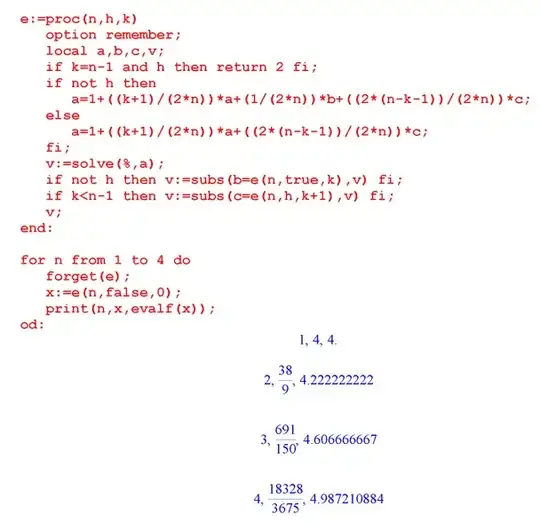Call a sequence of numbers from $[0,2n-1]$ completed if it contains two numbers that add to $2n$. If the earliest occurrence of two such numbers are at $n,m$ in the sequence, we say the sequence is completed at $m$ (the location of the second number). Call $a_m$ the number of sequences of length $m$ completed at $m$. $a_m$ is the total number of sequences of length $m$, minus the number of all sequences which had earlier completions, minus the number of incomplete sequences of length $m$ (call this $I_m$). That is,
$$a_m = (2n)^{m}-\left(\sum_{i=1}^{m-1} a_i (2n)^{m-i}\right) \ \ - I_m$$
since the number of sequences of length $m$ completed at $n$ is $a_n (2n)^{m-n}$ as we are free to choose whatever we like for the remaining numbers after completing.
An incomplete sequence is one that contains no pair of numbers that add to $2n$. Let us first consider incomplete sequences which do not contain the numbers $0$ or $n$ within them. In that case, we can have as many of each number as we wish within the sequence, as long as we do not have any of its pair. Let us fix the number of different digits we will have within our sequence, some $r$ with $1\leq r \leq n-1$. (If we have more than $n-1$ different numbers we will be including a pair and this will be a complete sequence, or be using $0$ or $n$.) We will choose these $r$ digits from the list $[1,n-1]$, giving us ${n-1}\choose r$ different sets of digits to use. But for each of these digits we can also choose to use its pair instead, so we actually have $2^r {{n-1}\choose{r}}$ different sets of digits to use. We just need to multiply this by the number of different sequences that use $r$ different digits and sum over $r$ to find the incomplete sequences not containing $0$ or $n$.
Now let $b_r^{(m)}$ denote the number of sequences of length $m$ that use $r$ different digits at least once. For instance, $b_1^{(m)}=1$ because there is only one sequence of length $m$ you can make with one digit, and $b_r^{(1)}=1$ if $r=1$ and $0$ if $r>1$, since there is no way to make a sequence of length $1$ using $2$ or more different digits at least once. Now let's find $b_r^{(m)}$. $b_0^{(m)}=0$ since with no digits you can not make a sequence. Now $b_r^{(m)}$ is the total number of sequences you can make from $r$ digits, minus the sequences that use less digits: fix a number $i$, $1\leq i \leq r-1$. Then we have counted the sequences formed by using only $i$ of our $r$ digits which is ${r \choose i}b_i$ (choose which digits are used in the sequence, and find how many sequences use just those digits); thus, we must subtract this off of the total number of sequences. Therefore,
$$b_r^{(m)}=r^m-\sum_{i=1}^{r-1}{r \choose i}b_i^{(m)}$$
Using this recurrence, we can show (by induction or generating functions) that
$$b_r^{(m)}=\sum_{i=0}^r {r\choose i}(-1)^{r+i}i^m$$
considering $0^0$ in this case to be $1$ so that $b_r^{(0)}=0$.
Then call the number of incomplete sequences of length $m$ not containing $0$ or $n$, $c_m$. From our above reasoning,
$$c_m=\sum_{r=1}^{n-1}2^r {{n-1}\choose{r}}b_r^{(m)}$$.
The rest is easy. Call the number of incomplete sequences of length $m$, now possibly containing $0$ but still not $n$, $C_m$. Then for each $i$, $0\leq i \leq m-1$ we can have $i$ zeros (plus the sequence of all zeros for $i=m$). We can choose to put them in ${m \choose i}$ positions, and we are left with an incomplete sequence containing no $0$s of length $m-i$. Thus
$$C_m = 1+ \sum_{i=0}^{m-1}{m\choose i}c_{m-i} = 1+ \sum_{i=1}^{m}{m\choose i}c_{i}$$
And finally we can introduce a single $n$ into the sequence in at most one of the $m$ positions in the sequence, so
$$I_m = C_m + m C_{m-1}$$
Now we have a recurrence for $a_m$, the number of sequences of length $m$ that are completed at the $m$th digit. Therefore $a_m/(2n)^m$ is the probability that we will first see a pair adding to $2n$ after picking $m$ digits. Thus the expected number of digits we will have to pick is
$$\sum_{m=1}^\infty m \frac{a_m}{(2n)^m}$$
In terms of the generating function $A(x)=\sum_{m=1}^\infty a_m x^m$, the probability is $A'(1/2n)/2n$.
I will look into finding closed forms tomorrow (spent my whole day on this already), but the problem is solved once a generating function or closed form is found for $I_m$.
Edit: The exponential generating function $\sum_{m=0}^\infty b_r^{(m)}\frac{x^m}{m!}=(e^x-1)^r$. From this we find the egf of $(I_m)$ is
$$(1+x)e^x[2e^x-1]^{n-1} = (1+x)\sum_{k=1}^{n}{{n-1}\choose {k-1}}(-1)^{n-k}2^{k-1} e^{kx}$$
Then we use Laplace transforms to find the ordinary generating function
$$I(s) = \sum_{m=0}^\infty I_m s^m = \sum_{k=1}^n{{n-1}\choose{k-1}}(-1)^{n-k}2^{k-1}\left[\frac{1}{1-sk}+\frac{s}{(1-sk)^2}\right]$$
and if we let $s=x/(2n)$ we get
$$I(x) = n\sum_{k=1}^n{{n-1}\choose{k-1}}(-1)^{n-k}2^{k}\left[\frac{1}{2n-xk}+\frac{x}{(2n-xk)^2}\right]$$
From our initial definitions we find
$$P(x)=\sum_{m=0}^\infty \frac{a_m}{(2n)^m}x^m=1-(1-x)I(x)$$
Then our expected value, in closed form, is
$$E(n)=P'(1)=n\sum_{k=1}^n{{n-1}\choose{k-1}}(-1)^{n-k}2^{k}\left[\frac{1}{2n-k}+\frac{1}{(2n-k)^2}\right]$$
$E(1)=4$ and $E(2)=\frac{38}{9}=4.222$, as expected.
We also find $E(3)=\frac{691}{150}=4.607$, $E(4)=\frac{18328}{3675}=4.987$, and $E(5)=\frac{424367}{79380}=5.346$.
